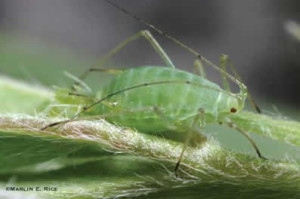 Aphids are small soft-bodied insects that suck plant juices. The whitish cast skins can be mistaken for whiteflies, an entirely different problem. That’s why it’s always best if you bring in a sample in a small plastic bag for diagnosis. The honeydew (sticky sugary sap) excreted provides an excellent medium for growing black sooty mold, many gardeners frequently mistake the sooty mold as the problem, when it is actually a symptom of aphid infestation. Copious honeydew and sooty mold can create a sticky, unsightly mess on trees, sidewalks, cars, and other surfaces beneath the plant.
Aphids are small soft-bodied insects that suck plant juices. The whitish cast skins can be mistaken for whiteflies, an entirely different problem. That’s why it’s always best if you bring in a sample in a small plastic bag for diagnosis. The honeydew (sticky sugary sap) excreted provides an excellent medium for growing black sooty mold, many gardeners frequently mistake the sooty mold as the problem, when it is actually a symptom of aphid infestation. Copious honeydew and sooty mold can create a sticky, unsightly mess on trees, sidewalks, cars, and other surfaces beneath the plant.Adult aphids are usually 1/8 inch, pear-shaped, with long legs and antennae, and vary from green, yellow, brown or red to black. Woolly aphids are covered with a waxy, whitish to gray coating (and may be mistaken for mealybugs). Woolly apple aphids can be found on apple trees, cotoneaster, hawthorn, pyracantha, elm, ash, and some conifers.
Aphids also have a pair of tube-like projections (cornicles) near the hind end of the body.
SYMPTOMS – Feeding by high populations can slow plant growth or cause leaves to yellow, curl, or drop early. Some species distort stems or fruit or cause galls birth to on roots, leaves, or stems. They can also transmit viruses, not usually a problem in landscape trees and shrubs.
During warm weather, aphids may go through a complete generation in less than 2 weeks. There are many generations per year, populations can increase rapidly in moderate temperatures. Throughout most of the year, adult aphids will give live young without mating! (They can also produce over wintering eggs, that’s why we suggest using dormant sprays starting in the fall.)
MANAGEMENT–
Sprays – Predators and parasites may not always appear in sufficient numbers until after aphids become abundant. To preserve beneficials use earth-friendly products like Bonide/EB Stone’s Insecticidal Soap, or Rose Defense, only in spots where aphids are most abundant. Use baits (Bonide, Grants, Terro) or sticky barriers (Tanglefoot/collars) to control honeydew-seeking ants, since they protect aphids from their natural enemies.
Mechanical Controls – Aphids can be hosed off with a strong stream of water or pinched by hand.
Biological Controls – Lady beetles (Hippodamia convergens) and their larvae, which resemble small black and orange crocodiles, the larvae of lacewings, are common predators, as well as many small wasps. The wasps lay their eggs inside the aphids, leaving “mummies” that are round and tan, with a small hole where the adult has chewed its way out.
Many aphid predators are attracted by the presence of honeydew, as well as nectar-producing plants.
Fish emulsion is one of the original organic fertilizers. It is a partially decomposed blend of finely pulverized fish parts. It is high in Nitrogen, and the source of several trace elements. The addition of Kelp helps with drought-resistance, frost-protection and stress recovery of the plant. Because it is water-soluble it is immediately available and can be used in early spring to gets plants going. Regular organic fertilizers cannot be broken down until the soil is warmer. Fish Emulsion can also be used as a foliar feed, even for tomatoes.


